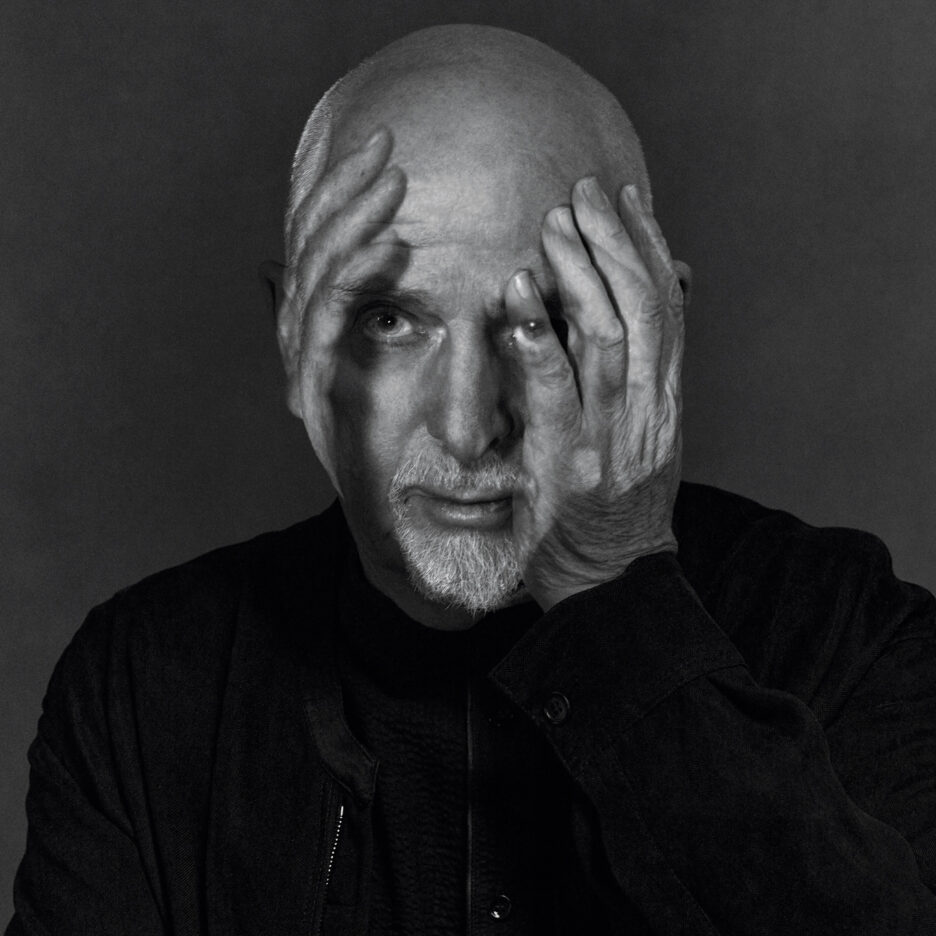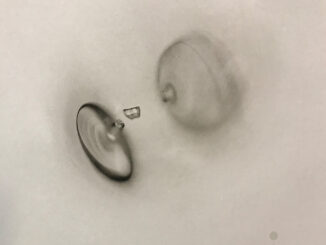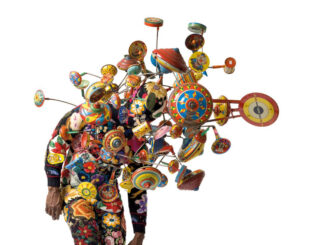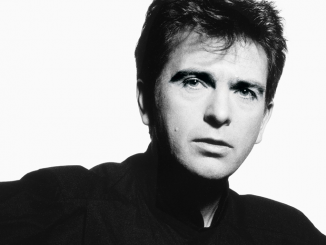The year is 2002. BBC 6 Music takes its first steps into the musical cosmos. In this cosmos, a star ceases to sparkle as we mourn the passing of Joe Strummer. Demonstrating the unpredictable aspects of said cosmos, Las Ketchup hit number one in the UK Singles Chart with ‘The Ketchup Song’, becoming the 938th chart-topper since the creation of the charts some 70 years previously. It was also when Peter Gabriel released his last album of new work, Up.
So, what can we expect from Mr Gabriel after all this time? Well, we kind of already know. Gabriel has released a track from his new album, i/o, on every full moon throughout 2023. Each track has been given time to breathe, find its way and enjoy its orbit. It is a little like those magazines where you must buy 100 issues at a tenner a pop to get all the parts to build a replica of a sports car or vintage aircraft. The key difference is that the parts were released for free on various platforms instead of paying a grand price to build a £50 toy car.
However, songs can take on a life as individual pieces. They can become quite different when listened to as part of a larger creation. And that’s where i/o comes in. Gabriel has done something a little different (doesn’t he always?) and has issued two different versions of the album, three if you include the 3-disc edition of this release, including Blu-ray. Mark ‘Spike’ Stent (released as the Bright-Side mix) and Tchad Blake (the Dark-Side mix) have mixed the twelve tracks for the LP and CD releases. The Dolby Atmos In-Side mix is provided on Blu-ray courtesy of Hans-Martin Buff. I’ll be focusing on the LP & CD versions for this review.
i/o delves into life, mortality, injustice, and our connection to the world. It’s nice to see Gabriel focusing on the lighter issues in life. In all seriousness, it wouldn’t harm us as a species to understand how we all interconnect with each other and the third rock from the Sun.
‘Panopticom’ gets things started with its lush production values. Gabriel posits the idea of flipping the surveillance state we live in, turning the focus on those in power. Think Big Brother in reverse. We could watch what they get up to and how they impact our lives and our planet. Where do I sign up for this? Sounds like a cracking idea. Listening to the track sometimes feels like you are sitting inside a computer network as data flows past you – very apt for the subject matter.
“We lost the line between the good and the bad/We lost the line between the sane and the mad”, Gabriel sings in ‘The Court’. Have we passed the point where injustices can be rebalanced? Can harmony ever be truly restored? It is a song packed to the rafters with thumping drums, and you are often surrounded by snippets of sound popping by to grab your attention.
With his voice sounding as if it is bouncing off rough sanded walls, Gabriel wrestles with the fact that we all will someday die in ‘Playing for Time’. Starting like a funeral march, the song quickly develops into a melancholic ballad. Strings and brass slowly appear, adding weight to their arrangement, expanding the song like a water balloon ready to burst. As the track enters its last stages, it explodes into a glorious, room-filling crescendo.
The album’s title track, i/o meaning input/output, embraces the interconnectivity of everything. After all, it is possible that there could be trace elements from the Big Bang in your body right now. Mind blown. “I’ll be laid to rest in my proper place/Into the roots of an old oak tree/Where life can move freely in and out of me”, Gabriel states to highlight our connection with the earth. I struggle to connect with this song for some reason. It may be because I feel it is too Phil Collins for my palette.
‘Four Kinds of Horses’ is inspired by a Buddhist parable about four different approaches to spiritual practice. It sees a classic Gabriel vocal bouncing around a moody sonic bubble. The track is another excellent example of the high production values on this album. Tackling a rather tricky subject, Gabriel views the conflict between the simultaneous pursuits of religion and terrorism – “They must have seen you looking/Watched everything you said/Knowing you could be a part of it/They fill your head – fill your head”.
A more up-tempo number comes next, which is an appreciated change of pace. ‘Road to Joy’ delivers the classic Gabriel rock sound. Lovely squelchy synth sounds bubble away beneath a swirl of electro noises, strings, guitar, vocals, and beats. This has been crafted with a hefty blob of funk at its core. The New Blood Orchestra and Soweto Gospel Choir conjoin with Gabriel to form a true highlight of this album. I feel re-energised for the second half.
We take a handbrake turn with ‘So Much’ – a gentle song dissecting the topic of mortality. With Gabriel and a piano taking centre stage, his vocal creates a claustrophobic feel, as if he is singing only for you inside the glovebox of a Mini Cooper. It creates a personal connection. It is almost uncomfortably intimate. “So much left to give/This edition is limited/There’s only so much can be done”, croons Gabriel with a gut-wrenching emotion.
‘Olive Tree’ is a riot of brass, bass, and a driving drum rhythm, creating an authentic 80s (and 20s as it happens) pop song. It has the sort of chorus that would have you grooving away without realising it if you heard it on the radio. What’s it about? I’ll let Gabriel explain. “In this story, our hero puts on the brain-scanning helmet that turns thoughts into pictures and then sees all the deep connections he has with the natural world and, in particular, to one olive tree.” Whilst sounding like a crazy 60s sci-fi B-movie plot, it is also something that feels as if it could happen in the very near future. The singularity gets closer by the day.
Life can be a challenge. Gabriel addresses ‘Love Can Heal’ to those who feel vulnerable, powerless, and unable to fight. It is a song of hope and positivity; the highlight is the beautiful strings, which lift this song away from being run-of-the-mill.
Home is a commonly used word. There’s no place like home. Home is where the heart is. Charity begins at home. But what is home? ‘This Is Home’ is another brooding song that feels like it has had a bad day and wants to get home and chill out. It very much fits with the theme of the song. It is essentially a love song, with safety, security and shelter being in the arms of a loved one. There is a warmth in Gabriel’s voice, acting as a vocal hug for your soul.
Gabriel also delves into his heartbreak. ‘And Still’ is an elegy for his recently departed mother and explores the nature of memory and how it anchors us and offers us refuge. Gabriel states he wanted to write a melody he thought his mother would have responded to. The song certainly creates goosebumps as Gabriel’s haunting vocals are wonderfully supported by a cello that cuts through your heart. The strings on this album are superb. Take a bow, New Blood Orchestra.
i/o takes us on a journey, sometimes to dark and futile places. This is a realistic reflection of life. However, Gabriel wants to leave us with hope and a healthy dose of positivity. ‘Live and Let Live’ certainly does that. There are some nice Sgt Pepper-esque strings, but the Soweto Gospel Choir steals the show. You cannot help but feel lifted by them here. It is as if they are mainlining dopamine straight into your body. The song has a Paul Simon feel blended with vintage Gabriel. “When we forgive, we can move on/Release all the shackles one by one/We belong to the burden/’ Till it’s gone”, proclaims Gabriel. Whilst it could be considered a bit trite, I don’t buy that. It is about time our species got a grip of itself and stopped being arseholes. Live and let live is not such a bad mantra.
i/o is not an album full of hit pop/rock songs, nor was it intended to be. True, a few of them could well exist happily in that sphere. However, when you build that vintage car with the parts Gabriel gave you, you understand what he wants to achieve with this album. It certainly knits together like an unusual and thought-provoking jumper.
Peter Gabriel doesn’t write songs so much as he develops soundscapes in which his thoughts exist. It leans into the art sphere, underlined by the works of art created by twelve artists – one for each track. You can appreciate these as you listen; all versions come with a 32-page booklet.
So, has i/o been worth the 21-year wait? Has Gabriel still got it? Overall, I would say yes. There are some gems in here, and I am sure the hardcore Peter Gabriel fans will be overjoyed with this album. It could have been a little tighter, though you would struggle to improve the production or the musicianship here.
So, do you go Bright-Side or Dark-Side? It doesn’t matter. While both mixes have some differences, neither offers a superior recording. The songs still work in the same way. No doubt the Gabriel fans who love their vinyl will buy both versions. They will enjoy them independently. I doubt they will greatly favour one over the other.





Be the first to comment